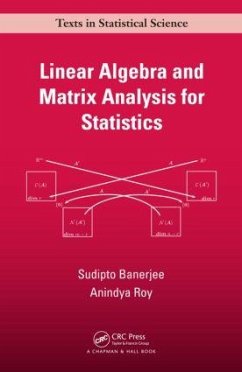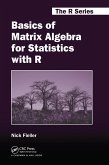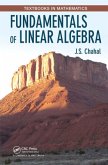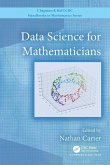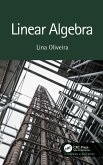Linear Algebra and Matrix Analysis for Statistics offers a gradual exposition to linear algebra without sacrificing the rigor of the subject. It presents both the vector space approach and the canonical forms in matrix theory. The book is as self-contained as possible, assuming no prior knowledge of linear algebra.
The authors first address the rudimentary mechanics of linear systems using Gaussian elimination and the resulting decompositions. They introduce Euclidean vector spaces using less abstract concepts and make connections to systems of linear equations wherever possible. After illustrating the importance of the rank of a matrix, they discuss complementary subspaces, oblique projectors, orthogonality, orthogonal projections and projectors, and orthogonal reduction.
The text then shows how the theoretical concepts developed are handy in analyzing solutions for linear systems. The authors also explain how determinants are useful for characterizing and deriving properties concerning matrices and linear systems. They then cover eigenvalues, eigenvectors, singular value decomposition, Jordan decomposition (including a proof), quadratic forms, and Kronecker and Hadamard products. The book concludes with accessible treatments of advanced topics, such as linear iterative systems, convergence of matrices, more general vector spaces, linear transformations, and Hilbert spaces.
The authors first address the rudimentary mechanics of linear systems using Gaussian elimination and the resulting decompositions. They introduce Euclidean vector spaces using less abstract concepts and make connections to systems of linear equations wherever possible. After illustrating the importance of the rank of a matrix, they discuss complementary subspaces, oblique projectors, orthogonality, orthogonal projections and projectors, and orthogonal reduction.
The text then shows how the theoretical concepts developed are handy in analyzing solutions for linear systems. The authors also explain how determinants are useful for characterizing and deriving properties concerning matrices and linear systems. They then cover eigenvalues, eigenvectors, singular value decomposition, Jordan decomposition (including a proof), quadratic forms, and Kronecker and Hadamard products. The book concludes with accessible treatments of advanced topics, such as linear iterative systems, convergence of matrices, more general vector spaces, linear transformations, and Hilbert spaces.
"... a unique and remarkable book ... has much to offer that is not found elsewhere. ... In Linear Algebra and Matrix Analysis for Statistics, Sudipto Bannerjee and Anindya Roy have raised the bar for textbooks in this genre. For me, this book will be an invaluable resource for my teaching and research. ... an outstanding choice for research-oriented statisticians who want a comprehensive theoretical treatment of the subject that will take them well beyond the prerequisites for the study of linear models."
-Journal of the American Statistical Association, Vol. 110, 2015
"The sixteen chapters cover the full range of topics ... Topics are presented in a logical order and in a reasonable pace. The book is compactly written and the approach throughout is rigorous, yet well readable. ... an excellent introduction to linear algebra."
-Zentralblatt MATH 1309
"This would be a reasonable candidate for use in a standard linear algebra course, even at institutions with no statistics majors. ... The proofs are very detailed and the authors bind the argument together with clear text that flows beautifully. ... Some linear algebra courses put a greater emphasis on concrete applications or on using software to get computations done. Other texts treat linear algebra as a branch of abstract algebra and allow spaces over arbitrary fields. This book is a strong contender for the vast majority of linear algebra courses that fall between those two extremes."
-MAA Reviews, October 2014
"This beautifully written text is unlike any other in statistical science. It starts at the level of a first undergraduate course in linear algebra, and takes the student all the way up to the graduate level, including Hilbert spaces. It is extremely well crafted and proceeds up through that theory at a very good pace. The book is compactly written and mathematically rigorous, yet the style is lively as well as engaging. This elegant, sophisticated work will serve upper-level and graduate statistics education well. All and all a book I wish I could have written."
-Jim Zidek, University of British Columbia, Vancouver, Canada
-Journal of the American Statistical Association, Vol. 110, 2015
"The sixteen chapters cover the full range of topics ... Topics are presented in a logical order and in a reasonable pace. The book is compactly written and the approach throughout is rigorous, yet well readable. ... an excellent introduction to linear algebra."
-Zentralblatt MATH 1309
"This would be a reasonable candidate for use in a standard linear algebra course, even at institutions with no statistics majors. ... The proofs are very detailed and the authors bind the argument together with clear text that flows beautifully. ... Some linear algebra courses put a greater emphasis on concrete applications or on using software to get computations done. Other texts treat linear algebra as a branch of abstract algebra and allow spaces over arbitrary fields. This book is a strong contender for the vast majority of linear algebra courses that fall between those two extremes."
-MAA Reviews, October 2014
"This beautifully written text is unlike any other in statistical science. It starts at the level of a first undergraduate course in linear algebra, and takes the student all the way up to the graduate level, including Hilbert spaces. It is extremely well crafted and proceeds up through that theory at a very good pace. The book is compactly written and mathematically rigorous, yet the style is lively as well as engaging. This elegant, sophisticated work will serve upper-level and graduate statistics education well. All and all a book I wish I could have written."
-Jim Zidek, University of British Columbia, Vancouver, Canada

